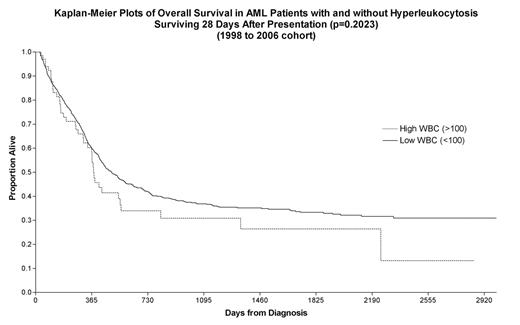Abstract
Patients with AML presenting with hyperleukocytosis (WBC >100x109/L) experience higher early mortality due to leukostasis. A retrospective comparison of 2 cohorts of patients managed in 2 different institutions either by leukapheresis (Princess Margaret Hospital n=42) or hydroxyurea (HU) (Toronto General Hospital n=47) demonstrated equivalent survival on days 8 (p=1.0000) and 28 (p=0.4784) after presentation. Based on this observation a policy was established to manage patients with HU rather than leukapheresis. The current study was designed to validate this policy. 1146 consecutive AML patients presented between 1998 and 2006 to the Princess Margaret Hospital at diagnosis. 105 of these patients had a WBC >100x109/L. According to the policy 85 were treated with a median cumulative dose of 18 gm HU within the first 4 days, 5 died before initiating treatment with HU and 15 underwent induction therapy without initial cytoreduction using HU. 35/105 patients (33%) died within the first 28 days. Patients presenting with symptoms of leukostasis, particularly with pulmonary involvement, were more likely to die within the first 28 days compared to patients without symptoms (p=0.0492). The death rate of 33% at 28 days was similar to those observed in the previous study (31% for the cohort undergoing leukapheresis and 23% for the cohort being treated with HU, p=0.5048). This rate was significantly higher when compared to 54/1041 (5%) patients dying before day 28 that presented with <100x109/L (p< 0.0001). Patients of both groups that survived more than 28 days (n=70 and n=987 respectively) demonstrated a similar overall survival. The 5 year overall survival amounted to 27% and 33% respectively (p=0.2023) and was influenced by the cytogenetic risk of patients at diagnosis (54 and 67% for patients with favourable, 28 and 30% with intermediate and 0 and 15% with unfavourable risk). In conclusion, hyperleukocytosis continues to be an adverse prognostic indicator affecting early mortality of patients with AML. Particularly patients that present with symptoms secondary to leukostasis are at risk for early death. The overall survival of patients surviving the first 28 days after presentation is not different. A treatment policy to use HU rather than leukapheresis in the immediate management of these patients confirmed a previous observation of equivalency.
Kaplan Meier plots of Overall Survival in AML Patients with and without Hyberleukocytosis (P< 0.001) (1998 to 2006 cohort)
Kaplan Meier plots of Overall Survival in AML Patients with and without Hyberleukocytosis (P< 0.001) (1998 to 2006 cohort)
Kaplan Meier plots of Overall Survival in AML Patients with and without Hyberleukocytosis Surviving 28 Days after Presentation (p = 0.2023) (1998 to 2006 cohort)
Kaplan Meier plots of Overall Survival in AML Patients with and without Hyberleukocytosis Surviving 28 Days after Presentation (p = 0.2023) (1998 to 2006 cohort)
Disclosure: No relevant conflicts of interest to declare.
Author notes
Corresponding author



